
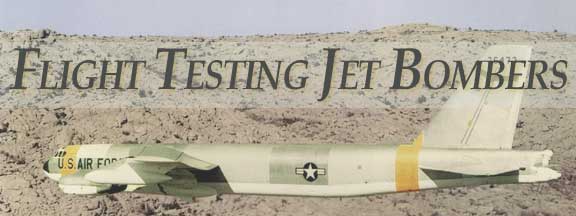
Flight Testing Jet Bombers. A Boeing Wichita Story
I flew on various B-52 test programs until I finally got my hands on a test program I could sink my teeth into, a structural demonstration, flight loads survey, and a landing loads survey. This program lasted a year. Besides performing the maneuvers required to get the structural loads on the airplane, a lot of aerial refueling was required to get the airplane up to weight. On a typical flight we took off at a gross weight of 400,000 Ibs. and refueled to 450,000 Ibs. or 488,000 Ibs. to get to the weight required for a demonstration point. At first the refueling was difficult until I learned how. The airplane involved was the B52G. Aerodynamically the wing was the same, but made of different aluminum, lighter and stronger. Refueling the B52G was more difficult than previous models. We blamed it on the lateral control system which used only spoilers. Previous models had ailerons and spoilers. The spoilers seemed more difficult to get small corrections with and they caused more pitching. During the first refueling I donít think I gained much fuel. I believe we burned almost as much fuel as we took on from the tanker. Finally I became proficient and we moved on down the road. It was a long program what with weather problems, instrumentation problems, and just a lot of points to get. Briefly it required 2 g pull-ups at max speed, and minimum speed, minus 1 g pushovers at maximum and minimum speeds. It required rolling pullouts at maximum roll rates, elevator reversals at certain speeds, many landings at various rates of sink, and a lot of roller coasters for instrumentation calibration. The demonstration had to be done at two different weights, 450,000 Ibs. and 488,000 Ibs. The g loadings were 2gs at 450,000 Ibs. and 1.8 gs. At 488,000 Ibs.
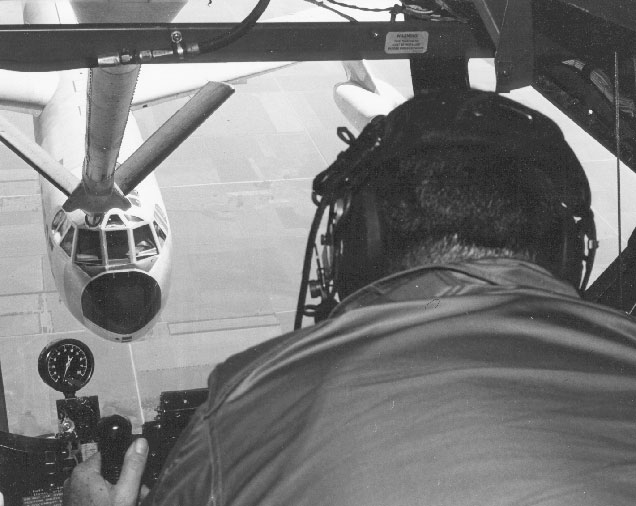
B52 in refueling position
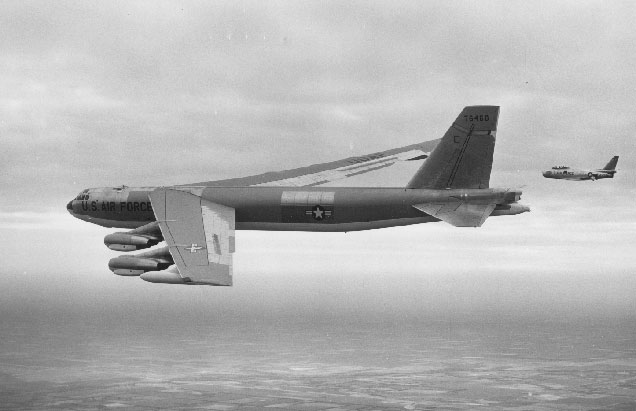
Test B52 with F86 chase plane
The max speed pull-ups did not seem to be a problem, but the max speed push overs were something else. I pushed for all I was worth and just barely made it. The low speed pull-up was a surprise. I hit buffet and the airplane pitched on up by itself. We got into severe buffet, and I thought I had broken the airplane. The buffeting was so bad I couldnít keep my feet on the rudder pedals. It turned out that as the airplane buffeted the wings were unloaded and nothing was hurt. The elevator reversals were difficult. I was supposed to reverse the elevators at a certain speed and g loading. For example at 250 kts pull up to 1.3g then rapidly push over to lg. I could not get calibrated. Finally one of the mechanics designed and built a stop to be put on the control column. Then all I had to do was establish the speed, pull back to the stop until the 1.5g was obtained then push forward to the other stop. It took a few tries to get the stops set right, then it worked fine.
Part of the demonstration was sideslip. For some reason the engineers wanted the sideslip measured to one tenth of a degree. We had no instrumentation that could measure that fine. Finally some one decided we should use the confetti method. A camera was sighted in looking dead ahead on the center line of the airplane. This camera was mounted in the cockpit. The airplane was flown in confetti dispensed by an airplane out in front. The sideslip was measured on the film taken from the cockpit camera. The sideslip angle was the angle between the cross hairs dead ahead and the confetti source as seen on film. It worked, but I would never recommend the method to any one else. It must have taken a ton of confetti. It took numerous flights with guys working like beavers in the tail of a KC-135 Tanker airplane filling the hopper of a confetti dispenser. I think they used buckets. The confetti clouds we flew in were so thick that twice we had to land without airspeed indications because the confetti had choked up our pitot tubes.
Another problem developed. The confetti was red and farmers began to complain about it lying in their fields, particularly the pastures. They said their cows were giving pink milk. I donít know how they found out where the confetti came from. That ended the confetti method. I think we were through anyway.
The landing loads survey was fun except for the early starting times. The landings required absolutely smooth air, and the only time we could be sure of that was very early in the morning, right at sun up. The test required landings at various rates of sink at max. landing weight. The toughy was max. rate of sink rear gear first. I always seemed to chicken out and pull up too much just before the rear gear struck the earth. I had to get the nose pretty high to get the rear gear to hit first. I finally decided to pull the spoilers up just before landing. This worked fine. The nose pitched up and the airplane fell like a ton of bricks. Completion of the landing loads survey completed the B52G structural test program.
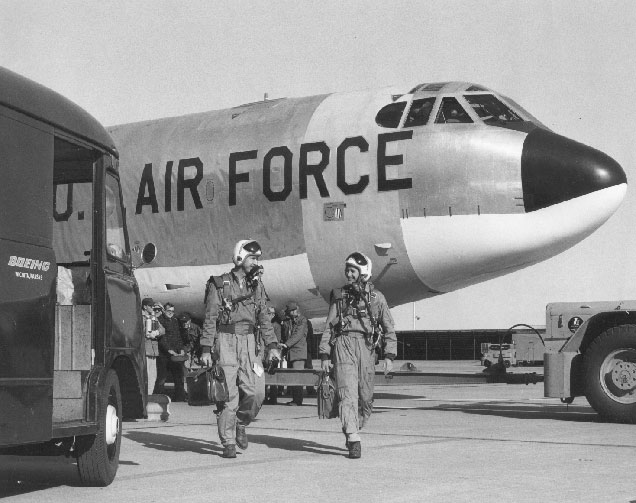
Dale Felix and Jim Goodell after structural demo flight
As with the B-47 it was decided that it was going to be difficult if not impossible to penetrate Russia with the B-52 at high altitude. A low-level test program came into being for the B-52. The idea was to fly the B-52 at low level a lot, 300 ft. above the ground, to see how it did and fix anything that needed fixing. The B-52 was not designed for low level flying, so it did not do very good. The first flights precipitated a lot of secondary structural failures. For example some of the skin on top of the horizontal stabilizer would occasionally peel off. It was found that the windshield got all bugged up so the pilots could not see out. I donít think that problem was ever solved. After a time a primary structural failure occurred and an airplane was lost. A test airplane out of Seattle went down near Burns, Oregon. The test airplane had made several test flights over a test course at speeds up to 400kts. The flight crews reported a lot of turbulence and a very rough ride on previous flights, but since the airplane was designed to withstand wind gusts up to 55kts. And gusts exceeding that speed rarely if ever occurred, no concern was felt for the safety of the airplane. The flight crews were concerned because it was brutal punishment. When the airplane crashed with the loss of the crew an investigation was started. In the meantime the flight crews refused to fly high speed low level flights. After reduction of the data from previous flights, it was found that the test airplane had encountered wind gusts of up to 80 feet per second. The design criteria of the airplane had been exceeded. On the particular accident the horizontal stabilizer of the airplane had failed and the airplane had dived into the ground in less than a second. There was no time to eject from the airplane. At the low altitude the airplane was flying it is doubtful that an ejection would have been successful anyway. This is one thing the flight crews objected to, that is being in a dangerous situation with no possible means of escape. The navigators were particularly unhappy because their ejection seats fired downward.
A fix for the horizontal stabilizer was arrived at and incorporated low level flight testing resumed. Flight crews were still unhappy about the situation but had no recourse short of quitting. Nobody did that because we all needed the money. It was decided to resume testing by gradually increasing the speed of low level flight. A low level course was selected running from south Texas to North Dakota and running along the eastern border of Colorado. The course was about a thousand miles long. The altitude to be flown was 300ft. above the ground and the speeds were to start at 300kts. And to be gradually increased to 400kts. On subsequent flights. Ray McPherson and I decided to go on these flights. He was the Chief of Flight Test for Boeing- Wichita at the time and I was his assistant. We thought we should assume the risk rather than ask other pilots. We found some willing navigators and got an occasional tail gunner from Boeing or the Air Force. The tail gunner position was the worst position because it was at the tail end of the whip. The participants back there got beat up and really needed their hard hats.
We pilots thought we could navigate by looking outside and referring to the map. It turned out to be impossible. Things went by too fast and at the low level there werenít enough land marks visible. The airplanes navigation system run by the navigator was necessary.
We made three trips. The last trip was made at 400kts. We smashed a lot of bugs, scared a lot of cattle, beat up several tail gunners, but we made it. The airplane was considered fixed, but the flight crews were not convinced. It just seemed like too much punishment for the airframe. One pilot. Jack Funk, described it as like flying formation with a bunch of loose parts. In the meantime the engineers were figuring out a way to do the thing on instruments using terrain clearing radar.
N.D. Showalter Jr was the project pilot on this program. He did an excellent job and became the expert on terrain clearing radar for the B-52. John Rutherford was another pilot who did a lot of low level flying with and without radar. John was an enigma. A lot of things about high altitude flying bothered him, flutter and such, but low level flying seemed to be his dish. I went with him on one flight over the Rockies when we started at the bottom of a 10,000 ft. ridge at 325 kts. And went over the top at less than 200kts. I wondered if we were going to run out of speed before we cleared the top. John flew it with all the confidence in the world.
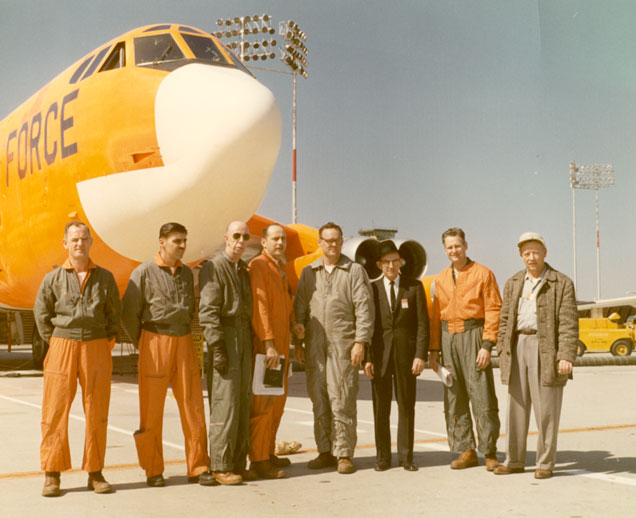
B52H Test Crew
Eventually another airplane broke. Chuck Fisher and crew were flying over the eastern edge of the Rockies when they hit severe turbulence and the vertical fin of the airplane broke off. This was a touch and go situation because the airplane had no directional stability and could easily have rolled over and gone in. They put the rear landing gear down, which gave them a little bit of stability, and flew the airplane to a base in Arkansas. The wind was calm there, so they were able to make a successful landing. Charlie was quite a hero after that, and rightfully so. After Charlieís incident it was back to the drawing board for structural fixes. Low level testing was resumed later, but at reduced airspeeds. Development and testing of terrain clearing radar continued.
B-52 production ended with the B-52H model in 1960, but the flight testing continued into the seventies and probably even into the eighties. After production stopped things gradually slowed up at Boeing-Wichita, and I became concerned about the future. Besides I had a management job that didnít involve flying. My boss, Ray McPherson offered me the opportunity to transfer to Seattle to fly the jet transports. I grabbed it in a hurry.
That was the end of Boeing-Wichita for me. It was quite an adventure, and I enjoyed it. I enjoyed working with the people and testing the jet bombers. They made the jet transports possible.
